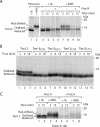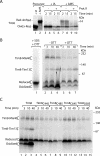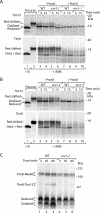Precursor oxidation by Mia40 and Erv1 promotes vectorial transport of proteins into the mitochondrial intermembrane space
- PMID: 17978092
- PMCID: PMC2174169
- DOI: 10.1091/mbc.e07-08-0814
Precursor oxidation by Mia40 and Erv1 promotes vectorial transport of proteins into the mitochondrial intermembrane space
Erratum in
- Mol Biol Cell. 2014 Apr;25(8):1408
Abstract
The mitochondrial intermembrane space contains chaperone complexes that guide hydrophobic precursor proteins through this aqueous compartment. The chaperones consist of hetero-oligomeric complexes of small Tim proteins with conserved cysteine residues. The precursors of small Tim proteins are synthesized in the cytosol. Import of the precursors requires the essential intermembrane space proteins Mia40 and Erv1 that were proposed to form a relay for disulfide formation in the precursor proteins. However, experimental evidence for a role of Mia40 and Erv1 in the oxidation of intermembrane space precursors has been lacking. We have established a system to directly monitor the oxidation of precursors during import into mitochondria and dissected distinct steps of the import process. Reduced precursors bind to Mia40 during translocation into mitochondria. Both Mia40 and Erv1 are required for formation of oxidized monomers of the precursors that subsequently assemble into oligomeric complexes. Whereas the reduced precursors can diffuse back into the cytosol, the oxidized precursors are retained in the intermembrane space. Thus, oxidation driven by Mia40 and Erv1 determines vectorial transport of the precursors into the mitochondrial intermembrane space.
Figures







Similar articles
-
In vivo evidence for cooperation of Mia40 and Erv1 in the oxidation of mitochondrial proteins.Mol Biol Cell. 2012 Oct;23(20):3957-69. doi: 10.1091/mbc.E12-05-0358. Epub 2012 Aug 23. Mol Biol Cell. 2012. PMID: 22918950 Free PMC article.
-
Structural and functional roles of the conserved cysteine residues of the redox-regulated import receptor Mia40 in the intermembrane space of mitochondria.J Biol Chem. 2009 Jan 16;284(3):1353-63. doi: 10.1074/jbc.M805035200. Epub 2008 Nov 14. J Biol Chem. 2009. PMID: 19011240
-
Mitochondrial Ccs1 contains a structural disulfide bond crucial for the import of this unconventional substrate by the disulfide relay system.Mol Biol Cell. 2011 Oct;22(20):3758-67. doi: 10.1091/mbc.E11-04-0296. Epub 2011 Aug 24. Mol Biol Cell. 2011. PMID: 21865601 Free PMC article.
-
Structural basis for the disulfide relay system in the mitochondrial intermembrane space.Antioxid Redox Signal. 2010 Nov 1;13(9):1359-73. doi: 10.1089/ars.2010.3099. Antioxid Redox Signal. 2010. PMID: 20136511 Review.
-
A disulfide relay system in mitochondria.Cell. 2005 Jul 1;121(7):965-7. doi: 10.1016/j.cell.2005.06.019. Cell. 2005. PMID: 15989945 Review.
Cited by
-
The redox environment in the mitochondrial intermembrane space is maintained separately from the cytosol and matrix.J Biol Chem. 2008 Oct 24;283(43):29126-34. doi: 10.1074/jbc.M803028200. Epub 2008 Aug 15. J Biol Chem. 2008. PMID: 18708636 Free PMC article.
-
Inhibition of proteasome rescues a pathogenic variant of respiratory chain assembly factor COA7.EMBO Mol Med. 2019 May;11(5):e9561. doi: 10.15252/emmm.201809561. EMBO Mol Med. 2019. PMID: 30885959 Free PMC article.
-
The ubiquitin-proteasome system regulates mitochondrial intermembrane space proteins.Mol Cell Biol. 2013 Jun;33(11):2136-48. doi: 10.1128/MCB.01579-12. Epub 2013 Mar 18. Mol Cell Biol. 2013. PMID: 23508107 Free PMC article.
-
Mitochondrial protein import: precursor oxidation in a ternary complex with disulfide carrier and sulfhydryl oxidase.J Cell Biol. 2008 Oct 20;183(2):195-202. doi: 10.1083/jcb.200804095. Epub 2008 Oct 13. J Cell Biol. 2008. PMID: 18852299 Free PMC article.
-
Deciphering structural and functional roles of individual disulfide bonds of the mitochondrial sulfhydryl oxidase Erv1p.J Biol Chem. 2009 Oct 16;284(42):28754-61. doi: 10.1074/jbc.M109.021113. Epub 2009 Aug 13. J Biol Chem. 2009. PMID: 19679655 Free PMC article.
References
-
- Allen S., Balabanidou V., Sideris D. P., Lisowsky T., Tokatlidis K. Erv1 mediates the Mia40-dependent protein import pathway and provides a functional link to the respiratory chain by shuttling electrons to cytochrome c. J. Mol. Biol. 2005;353:937–944. - PubMed
-
- Allen S., Lu H., Thornton D., Tokatlidis K. Juxtaposition of the two distal Cx3C motifs via intrachain disulfide bonding is essential for the folding of Tim10. J. Biol. Chem. 2003;278:38505–38513. - PubMed
-
- Bohnert M., Pfanner N., van der Laan M. A dynamic machinery for import of mitochondrial precursor proteins. FEBS Lett. 2007;581:2802–2810. - PubMed
-
- Chacinska A., et al. Mitochondrial presequence translocase: switching between TOM tethering and motor recruitment involves Tim21 and Tim17. Cell. 2005;120:817–829. - PubMed
Publication types
MeSH terms
Substances
LinkOut - more resources
Full Text Sources
Molecular Biology Databases

